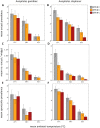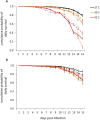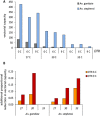Malaria transmission potential could be reduced with current and future climate change
- PMID: 27324146
- PMCID: PMC4914975
- DOI: 10.1038/srep27771
Malaria transmission potential could be reduced with current and future climate change
Abstract
Several studies suggest the potential for climate change to increase malaria incidence in cooler, marginal transmission environments. However, the effect of increasing temperature in warmer regions where conditions currently support endemic transmission has received less attention. We investigate how increases in temperature from optimal conditions (27 °C to 30 °C and 33 °C) interact with realistic diurnal temperature ranges (DTR: ± 0 °C, 3 °C, and 4.5 °C) to affect the ability of key vector species from Africa and Asia (Anopheles gambiae and An. stephensi) to transmit the human malaria parasite, Plasmodium falciparum. The effects of increasing temperature and DTR on parasite prevalence, parasite intensity, and mosquito mortality decreased overall vectorial capacity for both mosquito species. Increases of 3 °C from 27 °C reduced vectorial capacity by 51-89% depending on species and DTR, with increases in DTR alone potentially halving transmission. At 33 °C, transmission potential was further reduced for An. stephensi and blocked completely in An. gambiae. These results suggest that small shifts in temperature could play a substantial role in malaria transmission dynamics, yet few empirical or modeling studies consider such effects. They further suggest that rather than increase risk, current and future warming could reduce transmission potential in existing high transmission settings.
Figures



Similar articles
-
Temperature impacts the environmental suitability for malaria transmission by Anopheles gambiae and Anopheles stephensi.Ecology. 2022 Aug;103(8):e3685. doi: 10.1002/ecy.3685. Epub 2022 Jun 14. Ecology. 2022. PMID: 35315521 Free PMC article.
-
Mapping Physiological Suitability Limits for Malaria in Africa Under Climate Change.Vector Borne Zoonotic Dis. 2015 Dec;15(12):718-25. doi: 10.1089/vbz.2015.1822. Epub 2015 Nov 18. Vector Borne Zoonotic Dis. 2015. PMID: 26579951 Free PMC article.
-
Malaria vectors in South America: current and future scenarios.Parasit Vectors. 2015 Aug 19;8:426. doi: 10.1186/s13071-015-1038-4. Parasit Vectors. 2015. PMID: 26283539 Free PMC article.
-
A climate-based distribution model of malaria transmission in sub-Saharan Africa.Parasitol Today. 1999 Mar;15(3):105-11. doi: 10.1016/s0169-4758(99)01396-4. Parasitol Today. 1999. PMID: 10322323 Review.
-
Mathematical modeling of climate change and malaria transmission dynamics: a historical review.J Math Biol. 2018 Oct;77(4):857-933. doi: 10.1007/s00285-018-1229-7. Epub 2018 Apr 24. J Math Biol. 2018. PMID: 29691632 Review.
Cited by
-
Mean daily temperatures can predict the thermal limits of malaria transmission better than rate summation.bioRxiv [Preprint]. 2024 Sep 23:2024.09.20.614098. doi: 10.1101/2024.09.20.614098. bioRxiv. 2024. PMID: 39386442 Free PMC article. Preprint.
-
Influence of environmental, geographic, socio-demographic, and epidemiological factors on presence of malaria at the community level in two continents.Sci Rep. 2024 Jul 20;14(1):16734. doi: 10.1038/s41598-024-67452-5. Sci Rep. 2024. PMID: 39030306 Free PMC article.
-
Climate change and its impact on infectious diseases in Asia.Singapore Med J. 2024 Apr 1;65(4):211-219. doi: 10.4103/singaporemedj.SMJ-2023-180. Epub 2024 Apr 23. Singapore Med J. 2024. PMID: 38650059 Free PMC article. Review.
-
Estimating the effects of temperature on transmission of the human malaria parasite, Plasmodium falciparum.Nat Commun. 2024 Apr 22;15(1):3230. doi: 10.1038/s41467-024-47265-w. Nat Commun. 2024. PMID: 38649361 Free PMC article.
-
Morphometry of the wings of Anopheles aquasalis in simulated scenarios of climate change.Rev Soc Bras Med Trop. 2024 Apr 5;57:e00704. doi: 10.1590/0037-8682-0454-2023. eCollection 2024. Rev Soc Bras Med Trop. 2024. PMID: 38597525 Free PMC article.
References
Publication types
MeSH terms
Grants and funding
LinkOut - more resources
Full Text Sources
Other Literature Sources
Medical

